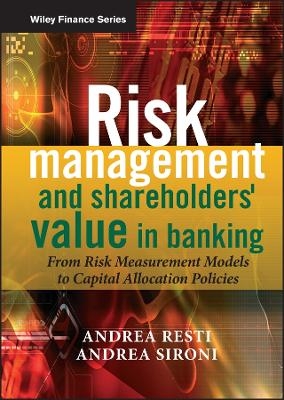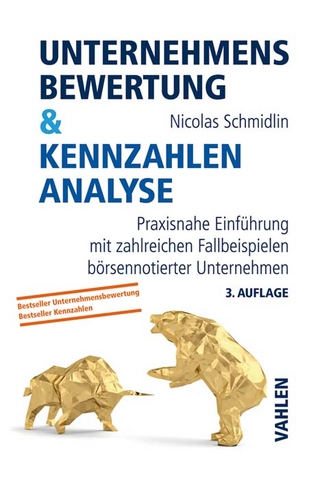
Risk Management and Shareholders' Value in Banking
John Wiley & Sons Inc (Verlag)
978-0-470-02978-7 (ISBN)
This book presents an integrated framework for risk measurement, capital management and value creation in banks. Moving from the measurement of the risks facing a bank, it defines criteria and rules to support a corporate policy aimed at maximizing shareholders' value.
Parts I - IV discuss different risk types (including interest rate, market, credit and operational risk) and how to assess the amount of capital they absorb by means of up-to-date, robust risk-measurement models. Part V surveys regulatory capital requirements: a special emphasis is given to the Basel II accord, discussing its economic foundations and managerial implications. Part VI presents models and techniques to calibrate the amount of economic capital at risk needed by the bank, to fine-tune its composition, to allocate it to risk-taking units, to estimate the "fair" return expected by shareholders, to monitor the value creation process. Risk Management and Shareholders' Value in Banking includes:
* Value at Risk, Monte Carlo models, Creditrisk+, Creditmetrics and much more
* formulae for risk-adjusted loan pricing and risk-adjusted performance measurement
* extensive, hands-on Excel examples are provided on the companion website www.wiley.com/go/rmsv
* a complete, up-to-date introduction to Basel II
* focus on capital allocation, Raroc, EVA, cost of capital and other value-creation metrics
ANDREA RESTI, formerly an officer at one of Italy's largest banks, has worked on Basel II issues for the Centre for European Policy Studies (Brussels). A consultant to several major banks, as well as to the Bank of Italy, he has held courses on credit risk for GARP and PRMIA. ANDREA SIRONI, formerly with Chase Manhattan Bank in London, has been a visiting scholar at the Stern School of Business (NYU) and at the Federal Reserve Board of Governors (Washington). He is currently Dean for International Affairs at Bocconi University (Milan) and a member of the Fitch Academic Advisory Board. The authors are both professors of Financial Markets and Institutions at Bocconi and have been teaching banking and finance for more than 15 years. Their publications comprise many articles in major international academic journals, as well as several risk management and banking textbooks, including a best-selling title on recovery risk.
Foreword xix
Motivation and Scope of this Book: A Quick Guided Tour xxi
Part I Interest Rate Risk 1
Introduction to Part I 3
1 The Repricing Gap Model 9
1.1 Introduction 9
1.2 The gap concept 9
1.3 The maturity-adjusted gap 12
1.4 Marginal and cumulative gaps 15
1.5 The limitations of the repricing gap model 19
1.6 Some possible solutions 20
Selected Questions and Exercises 25
Appendix 1A The Term Structure of Interest Rates 28
Appendix 1B Forward Rates 32
2 The Duration Gap Model 35
2.1 Introduction 35
2.2 Towards mark-to-market accounting 35
2.3 The duration of financial instruments 39
2.4 Estimating the duration gap 42
2.5 Problems of the duration gap model 45
Selected Questions and Exercises 47
Appendix 2A The Limits of Duration 49
3 Models Based on Cash-Flow Mapping 57
3.1 Introduction 57
3.2 The objectives of cash-flow mapping and term structure 57
3.3 Choosing the vertices of the term structure 58
3.4 Techniques based on discrete intervals 59
3.5 Clumping 64
3.6 Concluding comments 68
Selected Questions and Exercises 69
Appendix 3A Estimating the Zero-Coupon Curve 71
4 Internal Transfer Rates 77
4.1 Introduction 77
4.2 Building an ITR system: a simplified example 77
4.3 Single and multiple ITRs 79
4.4 Setting internal interest transfer rates 84
4.5 ITRs for transactions with embedded options 88
4.6 Summary: the ideal features of an ITR system 93
Selected Questions and Exercises 94
Appendix 4A Derivative Contracts on Interest Rates 96
Part II Market Risks 103
Introduction to Part II 105
5 The Variance-Covariance Approach 115
5.1 Introduction 115
5.2 VaR derivation assuming normal return distribution 115
5.3 Sensitivity of portfolio positions to market factors 126
5.4 Mapping of risk positions 133
5.5 Summary of the variance-covariance approach and main limitations 143
Selected Questions and Exercises 151
Appendix 5A Stockmarket Betas 154
Appendix 5B Option Sensitivity Coefficients: “Greeks” 157
6 Volatility Estimation Models 163
6.1 Introduction 163
6.2 Volatility estimation based upon historical data: simple moving averages 163
6.3 Volatility estimation based upon historical data: exponential moving averages 167
6.4 Volatility prediction: GARCH models 172
6.5 Volatility prediction: implied volatility 179
6.6 Covariance and correlation estimation 181
Selected Questions and Exercises 182
7 Simulation Models 185
7.1 Introduction 185
7.2 Historical simulations 189
7.3 Monte Carlo simulations 205
7.4 Stress testing 218
Selected Questions and Exercises 221
8 Evaluating VaR Models 225
8.1 Introduction 225
8.2 An example of backtesting: a stock portfolio VaR 225
8.3 Alternative VaR model backtesting techniques 232
Selected Questions and Exercises 244
Appendix 8A VaR Model Backtesting According to the Basel Committee 246
9 VaR Models: Summary, Applications and Limitations 251
9.1 Introduction 251
9.2 A summary overview of the different models 251
9.3 Applications of VaR models 253
9.4 Six “False Shortcomings” of VaR 260
9.5 Two real problems of VaR models 263
9.6 An Alternative Risk Measure: Expected Shortfall (ES) 268
Selected Questions and Exercises 269
Appendix 9A Extreme Value Theory 272
Part III Credit Risk 275
Introduction to Part III 277
10 Credit-Scoring Models 287
10.1 Introduction 287
10.2 Linear discriminant analysis 287
10.3 Regression models 299
10.4 Inductive models 301
10.5 Uses, limitations and problems of credit-scoring models 307
Selected Questions and Exercises 309
Appendix 10A The Estimation of the Gamma Coefficients in Linear Discriminant Analysis 311
11 Capital Market Models 313
11.1 Introduction 313
11.2 The approach based on corporate bond spreads 313
11.3 Structural models based on stock prices 321
Selected Questions and Exercises 340
Appendix 11A Calculating the Fair Spread on a Loan 342
Appendix 11B Real and Risk-Neutral Probabilities of Default 343
12 LGD and Recovery Risk 345
12.1 Introduction 345
12.2 What factors drive recovery rates? 346
12.3 The estimation of recovery rates 347
12.4 From past data to LGD estimates 351
12.5 Results from selected empirical studies 353
12.6 Recovery risk 356
12.7 The link between default risk and recovery risk 358
Selected Questions and Exercises 362
Appendix 12A The Relationship between PD and RR in the Merton model 364
13 Rating Systems 369
13.1 Introduction 369
13.2 Rating assignment 370
13.3 Rating quantification 379
13.4 Rating validation 388
Selected Questions and Exercises 398
14 Portfolio Models 401
14.1 Introduction 401
14.2 Selecting time horizon and confidence level 402
14.3 The migration approach: CreditMetricsTM 406
14.4 The structural approach: PortfolioManagerTM 423
14.5 The macroeconomic approach: CreditPortfolioViewTM 426
14.6 The actuarial approach: CreditRisk+TM 428
14.7 A brief comparison of the main models 439
14.8 Some limitations of the credit risk models 442
Selected Questions and Exercises 446
Appendix 14A Asset correlation versus default correlation 449
15 Some Applications of Credit Risk Measurement Models 451
15.1 Introduction 451
15.2 Loan pricing 451
15.3 Risk-adjusted performance measurement 457
15.4 Setting limits on risk-taking units 459
15.5 Optimizing the composition of the loan portfolio 461
Selected Questions and Exercises 462
Appendix 15A Credit Risk Transfer Tools 464
16 Counterparty Risk on OTC Derivatives 473
16.1 Introduction 473
16.2 Settlement and pre-settlement risk 474
16.3 Estimating pre-settlement risk 474
16.4 Risk-adjusted performance measurement 495
16.5 Risk-mitigation tools for pre-settlement risk 496
Selected Questions and Exercises 504
Part IV Operational Risk 505
Introduction to Part IV 507
17 Operational Risk: Definition, Measurement and Management 511
17.1 Introduction 511
17.2 OR: How can we define it? 512
17.3 Measuring OR 517
17.4 Towards an OR management system 533
17.5 Final remarks 535
Selected Questions and Exercises 537
Appendix 17A OR measurement and EVT 539
Part V Regulatory Capital Requirements 543
Introduction to Part V 545
18 The 1988 Capital Accord 547
18.1 Introduction 547
18.2 The capital ratio 549
18.3 Shortcomings of the capital adequacy framework 555
18.4 Conclusions 559
Selected Questions and Exercises 559
Appendix 18A The Basel Committee 563
19 The Capital Requirements for Market Risks 565
19.1 Introduction 565
19.2 Origins and characteristics of capital requirements 565
19.3 The capital requirement on debt securities 568
19.4 Positions in equity securities: specific and generic requirements 575
19.5 The requirement for positions in foreign currencies 576
19.6 The requirement for commodity positions 578
19.7 The use of internal models 578
Selected Questions and Exercises 585
Appendix 19A Capital Requirements Related to Settlement, Counterparty and Concentration Risks 588
20 The New Basel Accord 591
20.1 Introduction 591
20.2 Goals and Contents of the Reform 591
20.3 Pillar One: The Standard Approach to Credit Risk 593
20.4 The Internal Ratings-based Approach 597
20.5 Pillar Two: A New Role for Supervisory Authorities 612
20.6 Pillar Three: Market Discipline 614
20.7 Pros and Cons of Basel II 616
20.8 the Impact of Basel II 619
Selected Questions and Exercises 630
21 Capital Requirements on Operational Risk 633
21.1 Introduction 633
21.2 The capital requirement on operational risk 633
21.3 Weaknesses of the 2004 Accord 645
21.4 Final remarks 647
Selected Questions and Exercises 647
Part VI Capital Management and Value Creation 651
Introduction to Part VI 653
22 Capital Management 657
22.1 Introduction 657
22.2 Defining and measuring capital 658
22.3 Optimizing regulatory capital 675
22.4 Other instruments not included within regulatory capital 685
Selected Questions and Exercises 691
23 Capital Allocation 693
23.1 Introduction 693
23.2 Measuring capital for the individual business units 694
23.3 The relationship between allocated capital and total capital 702
23.4 Capital allocated and capital absorbed 712
23.5 Calculating risk-adjusted performance 715
23.6 Optimizing the allocation of capital 722
23.7 The organizational aspects of the capital allocation process 726
Selected Questions and Exercises 728
Appendix 23A The Correlation Approach 730
Appendix 23B The Virtual Nature of Capital Allocation 731
24 Cost of Capital and Value Creation 735
24.1 Introduction 735
24.2 The link between Risk Management and Capital Budgeting 735
24.3 Capital Budgeting in Banks and in Non-Financial Enterprises 736
24.4 Estimating the Cost of Capital 739
24.4.4 Caveats 744
24.5 Some empirical Examples 745
24.6 Value Creation and RAROC 750
24.7 Value Creation and EVA 753
24.8 Conclusions 756
Selected Questions and Exercises 757
Bibliography 759
Index 771
| Erscheint lt. Verlag | 1.5.2007 |
|---|---|
| Reihe/Serie | Wiley Finance Series |
| Verlagsort | New York |
| Sprache | englisch |
| Maße | 178 x 252 mm |
| Gewicht | 1488 g |
| Themenwelt | Sachbuch/Ratgeber ► Beruf / Finanzen / Recht / Wirtschaft ► Geld / Bank / Börse |
| Wirtschaft ► Betriebswirtschaft / Management ► Finanzierung | |
| Betriebswirtschaft / Management ► Spezielle Betriebswirtschaftslehre ► Bankbetriebslehre | |
| Wirtschaft ► Betriebswirtschaft / Management ► Unternehmensführung / Management | |
| ISBN-10 | 0-470-02978-1 / 0470029781 |
| ISBN-13 | 978-0-470-02978-7 / 9780470029787 |
| Zustand | Neuware |
| Haben Sie eine Frage zum Produkt? |
aus dem Bereich


